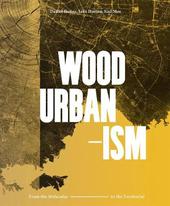
|
Wood Urbanism: From the Molecular to the Territorial
Paperback / softback
Main Details
Description
Wood holds a unique and timely lessons for urbanization, yet it remains inadequately characterized in architecture, landscape architecture, and urbanism. From under-considered thermal properties to emerging manufacturing possibilities, from changing forestry regimes to larger carbon cycle dynamics, Wood Urbanism explores the unique material and scalar properties of wood, presenting it as a critical material for design today. It brings into conversation scholars and practitioners who focus on wood from a range of perspectives-from the working forest to the mid-rise building to the basic cell. Drawing from the inherent intelligence and depth of multiple disciplines, this book offers a transcalar perspective on the role of wood in contemporary urbanization-from the imperceptibly small to the confoundingly large. With Contributions of Stefano Boeri, Izaskun Chinchilla, Azzurra Cox, Salmaan Craig, Oliver J. Curtis, Billie Faircloth, Tomas Folch, Mariano Gomez Luque, Jane Hutton, Daniel Ibanez, Renia Kagkou, David Kennedy, Matti Kuittinen, Garth Lenz, Charles Lindsay, Alex MacLean, Jacob Mans, Sean Mahoney, Aaron David Mendonca, Kiel Moe, Alan Organschi, Benjamin Peek, Albert Pope, Fernanda Rojas Marchini, Thomas Sherman, Julia Smachylo, Jonah Susskind, Juan Jose Ugarte & Jesus Vasallo.
Author Biography
Daniel Iba ez is a practicing Spanish architect and urbanist based in Cambridge, Massachusetts. He is founder and director of the design firm Margen-Lab, a cross-disciplinary design office conducting design that focuses on the intersection of design, energy, and ecology. At Harvard University, Iba ez is instructor and Doctor of Design candidate, editor of the New Geographies Journal and researcher at the Urban Theory Lab and the Office for Urbanization. Daniel's overall research critically seeks to frame the design disciplines in relation to broader socio-ecological processes and territorial interdependence through cross-disciplinary studies in the field of urban metabolism. Daniel is editor of other book publications including New Geographies 06: Grounding Metabolism (HUP, 2014) and Third Coast Atlas: Prelude to a Plan (Actar, 2017). His work as scholar and practicing architect has been recognized by the La Caixa Foundation, the Real Colegio Complutense at Harvard, the Venice Biennale of Architecture 2012, Oslo Triennale 2013 or the Boston Design Biennial 2017. Also, since 2015, Daniel is editor at urbanNext. Jane Hutton is a landscape architect and Assistant Professor at the University of Waterloo, Ontario, Canada, whose research focuses on the expanded consequences of material practice in design, examining links between the landscapes of production and consumption of common construction materials. She is currently completing a book manuscript (titled Reciprocal Landscapes: Cases in Material Movements, ) that traces five seminal landscape materials which ended up in New York City over the past century. Hutton is a co-founding editor of the journal Scapegoat: Architecture, Landscape, Political Economy, and is and is co-editor of Issues: 01 Service, 02 Materialism, and 06 Mexico D.F./NAFTA, which look at the political dimensions of material practice in design. Kiel Moe is Associate Professor of Architecture and Energy at the Harvard University Graduate School of Design where is also Co-Director of the MDes degree program in the Advanced Studies Program and Co-Director of the Energy, Environments, and Design research unit. He has published nine books on the relationship of architecture and energy including, most recently, Empire, State & Building; What is Energy & How (Else) Might We Think About It? with Sanford Kwinter; and Insulating Modernism: Isolated and Non-Isolated Thermodynamics in Architecture. In 2016 he was the Fulbright Distinguished Chair in Architecture in Finland and he is a Fellow of the American Academy in Rome. His work as a scholar and practicing architect has been recognized by the Architecture League of New York Prize, the Boston Design Biennial Award, and multiple fellowships at the MacDowell Colony.
Reviews"Building in timber is not as simple as designing a form and then -- harking back to my student days -- selecting wood rather than steel and concrete. It is most successful when the design process involves a deep understanding of the material's behavior, chemistry, ecology, and so forth. Wood Urbanism is not a one-stop shop for architects interested in building with mass timber rather than steel and concrete, but the book's trans-scalar, trans-disciplinary approach makes it a must for any designer who wants a broad, intellectual understanding of the potentials of the most sustainable material around." --John Hill, A Daily Dose of Architecture "From microscopic biology to the macrocosms of cities, wood has been an invaluable component of construction throughout history. Wood Urbanism explores the scalar properties of wood in terms of species, carbon impact, thermal qualities, ecology, cities, and metabolism. Case studies and visual essays are separated by full-spread photos and technical graphics that question the role of wood in today's industry. Both a manual and a challenge for architects, this book investigates how wood can continue to be a dynamic, multi-faceted material in an ever-changing landscape." --The Architect's Newspaper
|